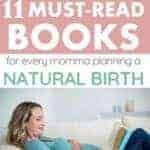
It really doesn’t matter what stage in your journey to motherhood you’re in right now. Truly, whether you’re still dreaming of the day you get to “actively try to conceive,” or you’re in full on TTC mode, or you’ve already seen the test stick turn positive, there is a book for you, friend.
Approaching pregnancy can be worrisome for women. Let’s face it; we didn’t all grow up on The Farm in Tennessee. If you don’t know what The Farm is, you’ll want to start with book number one.
But almost 4 million women have babies each and every year; so it stands to reason that the mechanics of it are fluid enough for each of us to learn to understand. (Source) That being said, not all births are amazing experiences, and ensuring you get something quality out of yours will be dependent upon what you put into it.
There are oodles of questions that come to mind when we start thinking about giving birth to our little ones, such as:
- Is home birth right for me?
- What do I need for a home birth?
- Are there more risks to home birth than hospital birth?
- How much does a home birth cost?
- How do I manage pain without an epidural?
There’s no shortage of information out there now, but you do need to know where to look.
So You Think You Know All There Is To Know About Home Birth
So you’re confident that you know enough about childbirth to know how it works, right? You’ve watched enough rom-coms by now to know that you have to reach that 10-centimeter goal before you can push your little heart out. You know your provider will start checking your cervix weeks before your estimated due date to make sure your body is progressing. You know that delayed cord clamping has been mentioned in the media enough by now that you should allow for a few extra seconds post-birth. You’ve got this.
But did you know pushing can actually delay your baby’s birth and increase the likelihood of perineal tears? (Source) Did you know cervical checks in late pregnancy don’t predict the onset of labor or how near it is at all? (Source) Did you know the cord should actually be left alone until no longer pulsating? (Source) Alright. Maybe you don’t know everything, but you can.
I rest my case. It’s the things you never knew you never knew that you need to worry about. What does this mean? It means even when you think you know it all, you probably don’t. Science is always changing. New studies reach new thresholds. We discover things even the pioneers of birth education never knew. It’s important to keep studying.
Why The Blogs Just Won’t Cut It
Listen, we can teach you a lot! But some things are best learned in-depth. We love blogs, obviously. But we love them because they are concise, most of the time. They are adequate summaries. They are light-hearted teaching points. We learn a thing or two, like how to mentally prep for the big day.
Most blogs are never going to be able to cover the vast knowledge that is the female anatomy. That would quickly become a web-based textbook if we tried, and then we would be losing the art of the blog.
Where Can I Learn More About Preparing For Home Birth?
How do you find information you aren’t aware of if you aren’t even aware that you aren’t aware? The fastest route to being able to make an informed decision is a centuries-old secret that’s been hidden from you right out in the open. It’s the good, old-fashioned book.
You might be able to find YouTube videos promising a crash course in birth. You might even find some worthwhile childbirth education seminars online or through local birth educators, doulas and hospitals. But you won’t find the knowledge behind them. You’ll get the end-points only, with no explanation of why a certain method, exercise or intervention is recommended.
Lucky for you, we’ve done some of the legwork already. Consider this your birthing Bible index. It will guide you to all of the educational materials a wannabe home birther could ever need.
The following list is by no means all-inclusive, but we’ve given attention to detail to make sure we cover all the basics—and then some—on not just home birth, but the art of natural childbirth and what your body was made to do. It’s time to reprogram the way you have been brought up to think of pregnancy and childbirth in this modern-day, medicalized era. Things are not what they seem, momma.
The Must-Read Books To Prepare For A Home Birth
Need a quick list that points you to every resource you don’t even know you need yet but will come to realize you couldn’t have birthed the same without them? Look no further.
1. Ina May’s Guide To Childbirth
It’s not likely you’ll ever enter any circle of women who have birthed naturally and not hear the name Ina May Gaskin echo from every corner. This pioneering midwife completely level all that modern women of the ’60s and since have thought they knew about birth, especially home birth.
Gaskin’s book, Ina May’s Guide to Childbirth, is literally just that. It is the foremost directive on giving birth in one’s natural and most primal state. Her book touts the importance of a birthing mother’s belief in her own self—in both physical and mental manners—because Gaskin knows the mind and body cannot be torn in two.
Ina covers details in this book that many other natural-themed texts just won’t, such as natural ways to induce labor and when that can actually be necessary.
Most mothers finish this book with a newfound sense of self-confidence, but some of us admittedly love it so much we flip to the front and read it again. The birth stories shared in this text come across more so like a friend sharing the magical experience of welcoming their child into the world than the boring medical texts of many other books today. A true classic, this piece continues to stand the test of time.
2. The Birth Partner
Dads don’t always know how to support the loves of their lives during childbirth—the most vulnerable moment of their lives, but The Birth Partner by Penny Simkin is a fantastic place to help them better understand their roles as labor and birth coaches.
Simkin digs deep into the critical importance of the labor coach—namely the father of the child. This book centers on caring for the mother during those last few—frequently uncomfortable—months. It extends into the early postpartum stage, too—often referred to as the fourth trimester.
If you’re looking for a resource that will teach you the tricks of the trade for knowing when it’s go-time, comparing pain management options and establishing a baby care routine post-birth, this is the book for you.
3. Spiritual Midwifery
While it comes across at the initial glance as something of a book for birth workers, Ina May Gaskin’s Spiritual Midwifery embarks on a journey aimed at teaching the everyday woman just how capable her body is of growing a child and nourishing it well into the toddler years.
This book can guide you on the muddied topic of how to choose a midwife, and that’s not all. It aims to give the layperson insight into midwifery practices throughout centuries. Needing advice on Vaginal Birth After Cesarean or even HBAC? Don’t skip this one then.
4. Orgasmic Birth: You’re Guide To A Safe, Satisfying, And Pleasurable Birth Experience
Yes, this ones sounds a little out there. It’s definitely not everyone’s cup of tea, but among those who do like it, they really like it. When Elizabeth Davis and Debra Pascali-Bonaro penned Orgasmic Birth: You’re Guide to a Safe, Satisfying, and Pleasurable Birth Experience, there’s no way they could’ve known to expect the outpouring of love and admiration that rose up for this book.
This text expands upon minor details mentioned by other authors, like Gaskin. It tackles the somewhat awkward topic of physical anatomy as it pertains to sexuality, and how the art of the orgasm may serve a biological purpose to aid in improving a woman’s birth experience. Go into this one with an open mind and prepare to be pleasantly surprised.
5. Unassisted Homebirth: An Act Of Love
At the forefront of may women’s minds when considering home birth is the age-old comparison of whether the home or the hospital is more suited for childbirth, and whether the midwife is a critical component or not. Unassisted Homebirth: An Act of Love was written with those mothers in mind.
While there is plenty of anecdotal experience touted in this book, there’s no shortage of research or evidence-based recommendations. As the unassisted birth movement continues to catapult itself back into the future it rightly belongs to, mothers are moved by a book that puts into words what they’ve felt all along: that their body and mind are their own and they are to be trusted.
6. The Father’s Home Birth Handbook
Author Leah Hazard doesn’t stop short in this book when it comes to encouraging Dad to not only support home birth as an option but be thrilled about it. She gives pregnant mothers the strength they need to present home birth as a solid and safe option to their male counterparts.
Hazard reassures male readers that their beloved other half won’t perish to childbirth, but that supporting her in the role of a home birth mother will help her to thrive versus just survive. Fathers-to-be take comfort in The Father’s Home Birth Handbook, knowing it gives them the confidence they need—and perhaps were severely lacking—to fulfill that role well.
7. The Essential Homebirth Guide: For Families Planning Or Considering Birthing At Home
So you’ve read the statistics, and you’ve drenched yourself in all things Gaskin and Simkin. Now, you find yourself as confident as ever that home birth is the right path for you, but that brings to light hundreds of new questions, like:
- What factors may cause you to risk out of home birth?
- Do you need a home birth pool?
- How many people should be present during the birth?
- Are other children ever too young or too old to be there?
The Essential Homebirth Guide: For Families Planning or Considering Birthing at Home is the first stop for all things birth prep. If you’re a planner, this is the book for you.
8. Childbirth Without Fear
Are you ready? Once you plummet yourself into the depths of Dr. Grantly Dick-Read’s world, you’re never the same again, and neither is the way you look at the birthing community surrounding you. Despite a modern-day notion that mothers should lament over their birth stories and terrify one another at the prospect of pushing a baby out of their bodies, women are wisening up. Books like this help.
This is the kind of book that is a must-have for the moms who are questioning whether they can have a home birth for their first baby. It’s the book for mothers who don’t understand how anyone could enjoy birth. It’s the book for every woman who is questioning why anyone would want to give birth without an epidural. Childbirth Without Fear is the precursor to an amazing natural birth experience.
9. Birthing From Within
To be frank, we’re not all lining up to subject ourselves to the most horrific pain people have ever described just so we can say we did it better than someone else did, or so we can claim our right to some invisible prize medal.
Birthing From Within appoints the mother-to-be as a woman in charge of her own destiny. It links the expectant momma to her inner divine self—the spirit inside that is driving her to claim her birth as a vital piece of who she is.
Authors, Pam England and Rob Horowitz, hammer home the importance of understanding birth as a gateway to learning who you’re meant to be—both as a woman and as a mother. If you’re seeking a companion book to address how to blend the world of creative expression, mindfulness and birth, look no further.
10. HypnoBirthing: The Mongan Method: The Breakthrough Approach To Safer, Easier, More Comfortable Childbirth
Pardoning the wordy title, there’s much that lies beneath the cover of this book. Author, Marie Mongan, went to great lengths to ensure fans of the HypnoBirthing methodology weren’t lost as to how to practice it.
A mixture of hypnosis and childbirth, many onlookers assume the experience is too psychology-based for their taste, but proponents of the method may find it’s far more of a spiritual practice than a medical one.
HypnoBirthing centers upon honing key skills—such as relaxation, positivity and visualization—to bolster the mother’s efforts toward having the most mindful birth experience she can.
11. Natural Childbirth The Bradley Way
Last but not least, the Bradley Method is a personal favorite of mine. I’ve yet to read anything on this method that didn’t delight me and school me just a little bit further than I thought possible.
The Bradley Method places a lot of focus on preparing the body for the physical process of labor, too. In Susan McCutcheon’s book, Natural Childbirth the Bradley Way, she adheres to Dr. Bradley’s wisdom on instructing a woman to birth like the fierce, wild spirit animal inside of her instinctually wants to.
The Bradley Method paints the perfect picture of what birth looks like in the wild amongst other mammals, and just how closely we mirror such. By the end of this book, you’re sitting atop a heap of knowledge that completely alters the way you view your own body—and the way you envision yourself physically giving birth.
If you don’t understand the importance of keeping your elbows up and out, and you don’t know how much difference your partner’s presence can make with regard to birth outcomes, you probably need a little more Dr. Bradley in your life.
How Much Are Books On Home Birth Going To Cost?
If the immense amount of home birth advice you’re going to gather from these books wasn’t incentive enough to buy them, the low price point on every single birth makes each one a pretty tempting offer as well. Fortunately, there are books on this list to suit nearly every budget.
But Wait… There’s More
You can certainly make use of multiple resources when educating oneself on home birth. While these books serve as purposeful guides in making sure you are fully informed on the functions of your own body during labor and childbirth, there are some things you just can’t learn from a chapter in a book. Thus, it is encouraged that you partake in:
- Childbirth education courses
- Conversations with midwives, doulas and other birth workers
- Participation in online or location-based support groups for natural childbirth
- Reading those light-hearted blogs that will prepare you for the reality of birthing at home
- Talking with your friends who’ve had home births
Knowledge Is Power When It Comes To Home Birth
Many of the books on this list not only give you a strong educational backbone to rely upon when making informed choices for yourself and your child, but they will bolster your own self-confidence.
Knowing more means you will feel more certain that you are making the right choices. Knowledge really is power in this case. The more you know, the less fear you feel. The more aware you are of everything that can happen during a home birth and how those events can be managed, the less you will worry about them occurring.
It really is the unknown that we fear the most. Consider the most common questions you find flowing through your mind at the onset of considering home birth.
- How will I cope with the pain?
- What if I can’t do it?
- What if the cord is around the baby’s neck?
- What if the baby is breech?
- What if contractions stall?
- What if the baby’s heart rate drops?
- What if I don’t like the water?
What if? What if? What if? It’s the worst form of curiosity. Instead of trying to pretend everything will go perfectly and that there isn’t anything to worry about, educate yourself on the protocol for managing those events if they occur. You’ll discover all of the concern around them then starts to melt away. You’ll find that once you know those issues can be safely managed, your trust in your midwife’s abilities multiples. And you’ll find that your trust in your body does, too.
Make sure to pin this post so you don’t lose this phenomenal list of MUST READ books.



